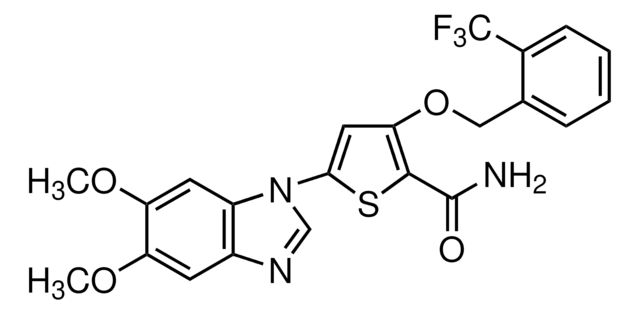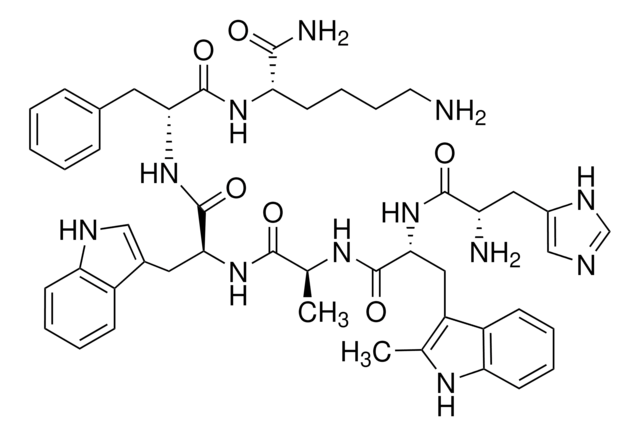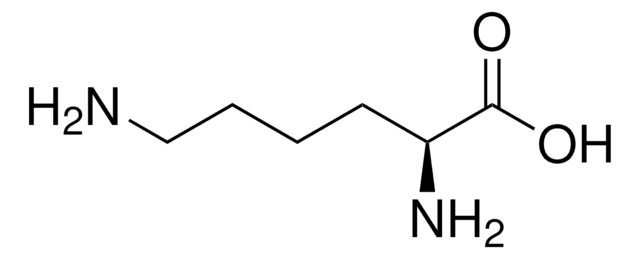G6771
Growth Hormone Releasing Factor Fragment 1-29 amide human
≥97% (HPLC)
About This Item
Polecane produkty
Poziom jakości
Próba
≥97% (HPLC)
temp. przechowywania
−20°C
ciąg SMILES
CC[C@H](C)[C@H](NC(=O)[C@H](C)NC(=O)[C@H](CC(O)=O)NC(=O)[C@H](C)NC(=O)[C@@H](N)Cc1ccc(O)cc1)C(=O)N[C@@H](Cc2ccccc2)C(=O)N[C@@H]([C@@H](C)O)C(=O)N[C@@H](CC(N)=O)C(=O)N[C@@H](CO)C(=O)N[C@@H](Cc3ccc(O)cc3)C(=O)N[C@@H](CCCNC(N)=N)C(=O)N[C@@H](CCCCN)C(=O)N[C@@H](C(C)C)C(=O)N[C@@H](CC(C)C)C(=O)NCC(=O)N[C@@H](CCC(N)=O)C(=O)N[C@@H](CC(C)C)C(=O)N[C@@H](CO)C(=O)N[C@@H](C)C(=O)N[C@@H](CCCNC(N)=N)C(=O)N[C@@H](CCCCN)C(=O)N[C@@H](CC(C)C)C(=O)N[C@@H](CC(C)C)C(=O)N[C@@H](CCC(N)=O)C(=O)N[C@@H](CC(O)=O)C(=O)N[C@@H]([C@@H](C)CC)C(=O)N[C@@H](CCSC)C(=O)N[C@@H](CO)C(=O)N[C@@H](CCCNC(N)=N)C(N)=O
InChI
1S/C149H246N44O42S/c1-20-77(13)116(191-122(211)81(17)168-132(221)104(66-113(204)205)178-121(210)79(15)167-123(212)88(152)62-84-39-43-86(198)44-40-84)145(234)185-102(63-83-32-23-22-24-33-83)138(227)193-118(82(18)197)146(235)186-103(65-111(155)202)137(226)189-108(71-196)142(231)182-101(64-85-41-45-87(199)46-42-85)136(225)175-93(38-31-56-165-149(161)162)126(215)174-91(35-26-28-53-151)131(220)190-115(76(11)12)143(232)184-97(58-72(3)4)124(213)166-68-112(203)170-94(47-49-109(153)200)128(217)180-100(61-75(9)10)135(224)188-106(69-194)140(229)169-80(16)120(209)172-92(37-30-55-164-148(159)160)125(214)173-90(34-25-27-52-150)127(216)179-99(60-74(7)8)134(223)181-98(59-73(5)6)133(222)176-95(48-50-110(154)201)129(218)183-105(67-114(206)207)139(228)192-117(78(14)21-2)144(233)177-96(51-57-236-19)130(219)187-107(70-195)141(230)171-89(119(156)208)36-29-54-163-147(157)158/h22-24,32-33,39-46,72-82,88-108,115-118,194-199H,20-21,25-31,34-38,47-71,150-152H2,1-19H3,(H2,153,200)(H2,154,201)(H2,155,202)(H2,156,208)(H,166,213)(H,167,212)(H,168,221)(H,169,229)(H,170,203)(H,171,230)(H,172,209)(H,173,214)(H,174,215)(H,175,225)(H,176,222)(H,177,233)(H,178,210)(H,179,216)(H,180,217)(H,181,223)(H,182,231)(H,183,218)(H,184,232)(H,185,234)(H,186,235)(H,187,219)(H,188,224)(H,189,226)(H,190,220)(H,191,211)(H,192,228)(H,193,227)(H,204,205)(H,206,207)(H4,157,158,163)(H4,159,160,164)(H4,161,162,165)/t77-,78-,79-,80-,81-,82+,88-,89-,90-,91-,92-,93-,94-,95-,96-,97-,98-,99-,100-,101-,102-,103-,104-,105-,106-,107-,108-,115-,116-,117-,118-/m0/s1
Klucz InChI
WGWPRVFKDLAUQJ-MITYVQBRSA-N
informacje o genach
human ... GHRH(2691) , GHRHR(2692)
Szukasz podobnych produktów? Odwiedź Przewodnik dotyczący porównywania produktów
Amino Acid Sequence
Opis ogólny
Działania biochem./fizjol.
Inne uwagi
Kod klasy składowania
11 - Combustible Solids
Klasa zagrożenia wodnego (WGK)
WGK 3
Temperatura zapłonu (°F)
Not applicable
Temperatura zapłonu (°C)
Not applicable
Środki ochrony indywidualnej
Eyeshields, Gloves, type N95 (US)
Certyfikaty analizy (CoA)
Poszukaj Certyfikaty analizy (CoA), wpisując numer partii/serii produktów. Numery serii i partii można znaleźć na etykiecie produktu po słowach „seria” lub „partia”.
Masz już ten produkt?
Dokumenty związane z niedawno zakupionymi produktami zostały zamieszczone w Bibliotece dokumentów.
Klienci oglądali również te produkty
Nasz zespół naukowców ma doświadczenie we wszystkich obszarach badań, w tym w naukach przyrodniczych, materiałoznawstwie, syntezie chemicznej, chromatografii, analityce i wielu innych dziedzinach.
Skontaktuj się z zespołem ds. pomocy technicznej


![[D-Ala2]-Growth Hormone Releasing Factor 1-29 amide human](/deepweb/assets/sigmaaldrich/product/images/425/958/5625d4d1-aa4a-42c0-a2f9-ff450404f2fe/640/5625d4d1-aa4a-42c0-a2f9-ff450404f2fe.jpg)
![[D-Lys3]-GHRP-6 synthetic, lyophilized powder](/deepweb/assets/sigmaaldrich/product/structures/386/044/971c33d0-e117-4aad-bf07-27172c088df1/640/971c33d0-e117-4aad-bf07-27172c088df1.png)








